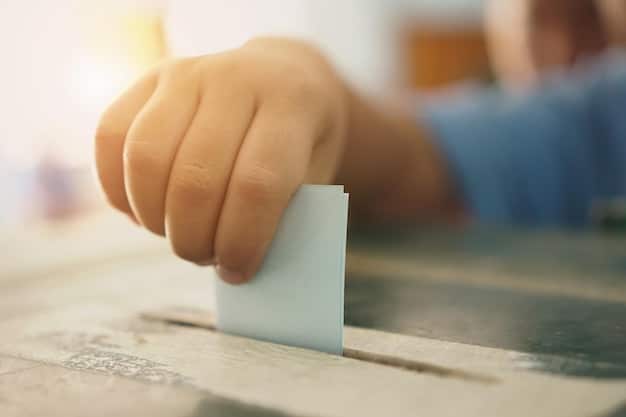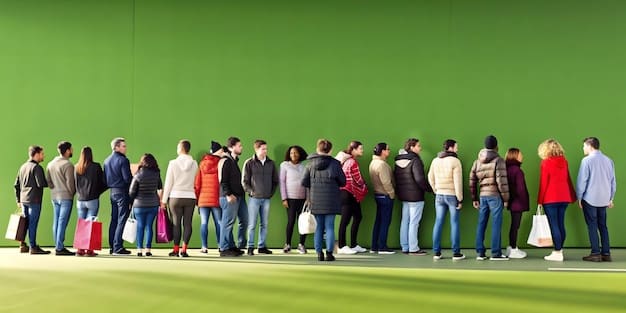Supreme Court Ruling: Impact on US Voting Rights Explained

Anúncios
Breaking: Supreme Court Ruling Impacts Voting Rights Across the Nation, potentially altering election access through changes to existing legal frameworks and voter regulations.
The nation’s attention is focused on a landmark decision: Breaking: Supreme Court Ruling Impacts Voting Rights Across the Nation. This pivotal judgment could reshape the landscape of American elections and how citizens exercise their fundamental right to vote.
Anúncios
Understanding the Supreme Court’s Decision on Voting Rights
The Supreme Court’s recent ruling has sent ripples across the country, particularly concerning its impact on voting rights. The decision, reached after months of deliberation, addresses key aspects of election law and voter access.
Anúncios
This section aims to break down the complexities of the ruling, providing clarity on what it entails and how it potentially reshapes the voting landscape.
Key Aspects of the Ruling
The Supreme Court’s decision focused on several core elements of existing voting rights legislation. Understanding these key aspects is critical to grasping the full impact of the ruling.
- Redistricting: The ruling addresses the legality of redistricting maps and their potential to unfairly disenfranchise minority voters.
- Voter ID Laws: The decision touches on the constitutionality of strict voter ID laws and their differential impact on various demographic groups.
- Early Voting and Registration: The ruling considers challenges related to early voting periods and same-day voter registration, potentially affecting voter turnout.

Ultimately, the specifics of the ruling will determine its real-world effects on future elections. The decision could reshape the dynamics of voter participation and influence the balance of power in legislative bodies.
Historical Context of Voting Rights in the US
Voting rights in the United States have always been a battleground. Looking back can reveal the long and sometimes arduous path toward universal suffrage and equal representation.
This section explores the historical context surrounding voting rights in the US, providing insights into the ongoing struggle for fair and accessible elections.
Landmark Voting Rights Cases
Throughout American history, numerous legal challenges have shaped the landscape of voting rights. Examining these landmark cases illustrates the evolution of legal interpretations and protections.
- Smith v. Allwright (1944): This case struck down the white primary system, a practice used in the South to exclude Black voters from primary elections.
- Baker v. Carr (1962): The Supreme Court ruled that federal courts could hear cases alleging that a state’s voting districts diluted the votes of certain residents.
- Shelby County v. Holder (2013): This decision weakened the Voting Rights Act of 1965 by removing the requirement for certain states with a history of discrimination to obtain federal approval before changing their voting laws.
The fight for voting rights continues to evolve, demonstrating an ongoing need for vigilance and advocacy.
The Potential Impact on Minority Communities
One of the most significant concerns surrounding the recent Supreme Court ruling is its potential impact on minority communities. Historically, these communities have faced systemic barriers to voting.
This section examines how the current ruling might affect minority voters and their participation in the electoral process.
Disenfranchisement Risks
The ruling could lead to new or reinstated voting restrictions that disproportionately affect minority voters. Understanding these risks is crucial for safeguarding equal access to the ballot box.
Potential risks include:
- More Restrictive Voter ID Laws: These laws may disenfranchise individuals who lack the necessary identification, particularly those in minority communities.
- Reduced Early Voting Opportunities: Limiting early voting periods could make it more difficult for individuals with inflexible work schedules or transportation challenges to vote.
- Aggressive Voter Roll Purges: Erroneous or discriminatory voter roll purges could disproportionately remove eligible minority voters from the rolls.

By actively engaging in voter education, advocacy, and legal challenges, it may be possible to mitigate the potential damage to the voting rights of minority communities.
Reactions from Political Parties and Advocacy Groups
The Supreme Court’s decision has elicited a wide range of reactions from political parties, advocacy groups, and individual citizens. Understanding these responses is essential to gauging the broader implications of the ruling.
This section provides an overview of the diverse perspectives on the court’s decision, reflecting the multifaceted political landscape of the United States.
Statements from Key Stakeholders
Political parties and advocacy groups have released official statements outlining their positions on the Supreme Court’s decision. These statements reflect the diverse interpretations of the ruling and its potential consequences.
- Democratic Party: Democratic leaders have largely condemned the decision, arguing that it undermines voting rights and threatens the integrity of American elections. They have pledged to pursue legislative and legal avenues to counteract the ruling’s effects.
- Republican Party: Republican leaders have generally supported the ruling, arguing that it reinforces election security and prevents voter fraud. They maintain that states should have the flexibility to implement their own voting regulations.
- Voting Rights Advocacy Groups: Groups like the American Civil Liberties Union (ACLU) and the NAACP Legal Defense and Educational Fund have expressed deep concern over the ruling. They are preparing legal challenges to restrictive voting laws enacted in response to the decision.
The array of reactions underscores the deeply divided perspectives on voting rights in the United States.
The Role of State Legislatures Moving Forward
With the Supreme Court’s decision in place, state legislatures are now poised to play a pivotal role in shaping voting regulations. Their actions in the coming months and years will determine the extent to which the ruling impacts voter access.
This section explores the potential actions state legislatures might take in response to the Supreme Court’s decision, and the implications of these actions for voting rights across the country.
Potential Legislative Actions
State legislatures could pursue a variety of legislative actions in response to the Supreme Court’s ruling. These actions span the spectrum from expanding voter access to implementing stricter voting restrictions.
Possible actions include:
- Enacting More Restrictive Voter ID Laws: Some states may introduce or strengthen voter ID laws, requiring voters to present specific forms of identification at the polls.
- Reducing Early Voting Periods: States may shorten the periods during which voters can cast their ballots early, potentially decreasing voter turnout.
- Limiting Same-Day Voter Registration: Restrictions on same-day voter registration could prevent eligible individuals from registering and voting on Election Day.
The actions taken by state legislatures will significantly shape the future of voting rights in the United States.
What Individuals Can Do to Protect Voting Rights
While the Supreme Court’s decision may seem daunting, individuals can take meaningful actions to protect voting rights in their communities. Collective action can make a significant difference in safeguarding fair and accessible elections.
This section outlines practical steps individuals can take to advocate for voting rights and ensure that all eligible citizens have the opportunity to participate in the democratic process.
Ways to Get Involved
Individuals can engage in a variety of activities to protect voting rights and promote voter participation. These activities include:
- Registering to Vote: Ensure that you and eligible members of your community are registered to vote. Regularly check your voter registration status to confirm your information.
- Volunteering for Voter Registration Drives: Organize or participate in voter registration drives to reach unregistered individuals and help them complete the necessary paperwork.
- Contacting Elected Officials: Contact your elected officials at the local, state, and federal levels to express your views on voting rights legislation. Urge them to support measures that protect and expand access to the ballot box.
By taking proactive steps, individuals can help ensure that voting rights are preserved and protected for all citizens.
| Key Point | Brief Description |
|---|---|
| ⚖️ SCOTUS Ruling | A Supreme Court decision impacts voting rights nationwide. |
| 🗳️ Minority Impact | Potential for increased disenfranchisement within minority communities. |
| 🏛️ State Actions | State legislatures will shape future voting regulations. |
| 📣 Citizen Action | Individuals can protect voting rights through registration and advocacy. |
Frequently Asked Questions
▼
The Supreme Court ruling addressed core aspects of election law, including redistricting, voter ID laws, and early voting, potentially reshaping voter access across the nation.
▼
The decision could lead to more restrictive voting measures. This could result in fewer early voting opportunities, and potentially aggressive voter list purges.
▼
State legislatures will now play a key role in shaping voting regulations by either expanding voter access or enacting stricter voting rules, based on the parameters the ruling sets.
▼
Yes, individuals can register voters, volunteer in drives, advocate to elected officials, and support organizations dedicated to voting rights to ensure fair elections.
▼
Arguments often revolve around election security concerns. The idea is to prevent fraud and ensure fair elections, as well as states’ rights when implementing voting laws.
Conclusion
The Breaking: Supreme Court Ruling Impacts Voting Rights Across the Nation, setting the stage for significant change. The decision requires careful consideration as individuals advocate for inclusivity in the democratic process.